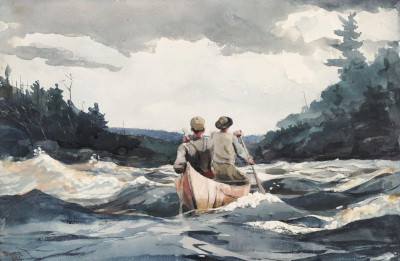 Buy Art Prints Now
Buy Art Prints Nowfrom Amazon
* As an Amazon Associate, and partner with Google Adsense and Ezoic, I earn from qualifying purchases.
This delightful watercolour painting by Winslow Homer features two canoeists heading through the North American landscape. The artist was highly talented in the use of both oils and these water-based options, bringing different styles to his oeuvre.
The scene is carefully constructed so that we can view the landscape in much the same way as the canoeists would have done as they head through the rapids. We are placed directly behind them for this purpose, allowing us to observe them in detail, as well as the scene that they are cautiously heading through. Those that look closely will be able to find drawn strokes that were completed using graphite, presumably in order to lay out the piece prior to adding the watercolours over the top. This technique helped to add a little more precise detail and we can see touches of this method on the canoeists' clothing, for example. The overhanging sky, with trees lining the two banks is delivered in the typical watercolour method, with regions of colour layered besides each other. The rapids however are more complicated, with series of white and blue paint woven together to produce a feeling of activity and drama as they head down the river. Homer would become most famous for his seascapes and mastered this genre in both oils and watercolours, with the two alternatives bringing something a little different to each other.
Canoe in the Rapids is on display at the Fogg Museum, at the time of writing, and is credited to the Louise E. Bettens Fund. The artist signed the watercolour in the bottom left corner, alongside its date of 1897. As is typical for this art medium, Homer used a relatively small piece of paper, which measures 35.4 cm by 53.3 cm. Normally, artists would work from pages within a sketchbook and so each artwork would end up the same size, after later being removed from the book and sold or gifted separately. Canoe in Rapids is also sometimes known instead as Men in a Canoe. Homer experimented within his seascapes to a considerable level, varying the role of humanity within each piece. Some would be entirely devoid of people, others would use them as a supporting element, such as to provide a sense of perspective. In this piece we are encouraged to see this landscape from the canoeist's own angle, essentially joining them on their exciting journey through the rapids.
The Fogg Museum is a part of the Harvard Art Museums and it is believed that they acquired this piece in 1924. It has been allowed out several times for various exhbitions, elsewhere in the country. It has not been as deeply researched as other seascape paintings from his career, but much of what we understand can be seen directly from viewing the piece. Its precise date of 1897 also allows us to pinpoint the piece within the artist's movements which have been well documented. He had certain regions in which he would work, helping to bring these locations to the public's consciousness through his famous artworks. Today he is righly regarded as one of the most famous and influential American artists of all time, and is best remembered for his contributions to the sescape genre.



